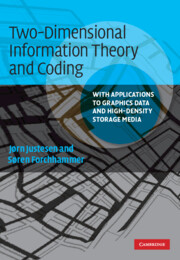 Two-Dimensional Information Theory and Coding
Two-Dimensional Information Theory and Coding Book contents
- Frontmatter
- Contents
- Preface
- 1 Introduction to information theory
- 2 Finite-state sources
- 3 Channels and linear codes
- 4 Reed–Solomon codes and their decoding
- 5 Source coding
- 6 Information in two-dimensional media
- 7 Constrained two-dimensional fields for storage
- 8 Reed–Solomon codes in applications
- Appendix A Fast arithmetic coding
- Appendix B Maximizing entropy
- Appendix C Decoding of Reed–Solomon code in F (16)
- Index
5 - Source coding
Published online by Cambridge University Press: 05 June 2012
- Frontmatter
- Contents
- Preface
- 1 Introduction to information theory
- 2 Finite-state sources
- 3 Channels and linear codes
- 4 Reed–Solomon codes and their decoding
- 5 Source coding
- 6 Information in two-dimensional media
- 7 Constrained two-dimensional fields for storage
- 8 Reed–Solomon codes in applications
- Appendix A Fast arithmetic coding
- Appendix B Maximizing entropy
- Appendix C Decoding of Reed–Solomon code in F (16)
- Index
Summary
This chapter treats source coding, with a focus on the basics of lossless coding of image and graphic data. Data compression and image coding are widely used today when transmitting and storing data. Examples are transmission of images on the Internet and storage of images, audio files, and video on CDs or DVDs.
In Chapter 1 source coding of discrete sources generating independent symbols was introduced, specifically in the form of Huffman codes and arithmetic coding. In Chapter 2 some source models were considered. In this chapter we treat source coding of statistically dependent data. Furthermore, for real-world data the model is unknown, so this chapter also deals with issues concerning efficiently estimating model parameters and possibly the model order for source coding. Actually, the standard notion of a model may be abandoned altogether and the goal may be to code a single individual sequence, i.e. independently of other sequences and their statistics.
First we consider how to code the source data in relation to the models previously defined. In general terms, the model is represented by a context defining a dependency on the past data.
We shall refer to the approach as context-adaptive coding. The context may readily be defined in two or more dimensions. Doing so naturally leads to source coding of images. This forms the basis of the binary image-coding standards originally developed for fax coding and today used in a number of applications including the widely used PDF (Portable Document Format) format.
- Type
- Chapter
- Information
- Two-Dimensional Information Theory and CodingWith Applications to Graphics Data and High-Density Storage Media, pp. 66 - 85Publisher: Cambridge University PressPrint publication year: 2009
